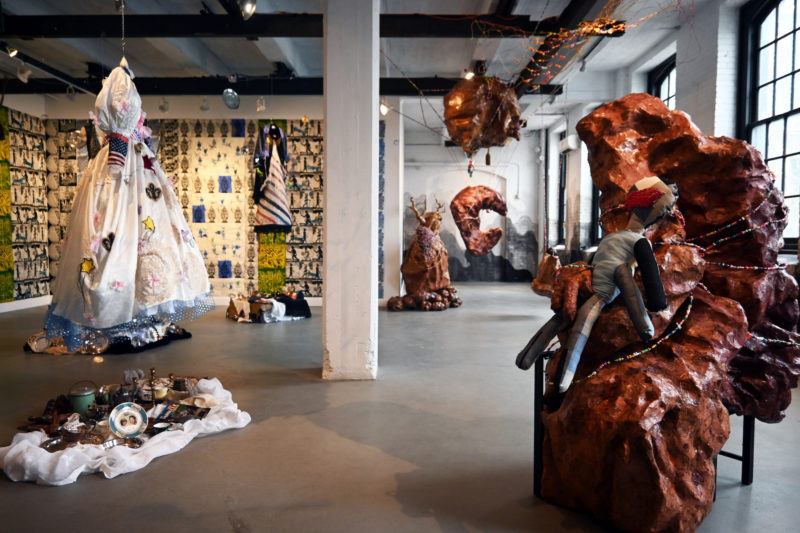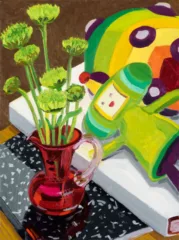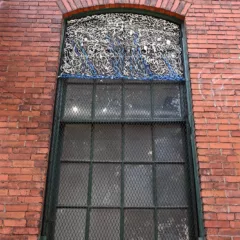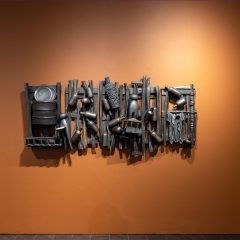
Post by Cheryl Harper
My family history is a fraught one, but I found irony between my Jewish family’s loss during the Holocaust and my husband’s family history of enslaving individuals for over 150 years on plantations in the South, one that I needed to explore as an artist. I was especially interested in exploring a dialog on the enslavement of African people compared to the genocide of Jewish people. My research and consequent thinking comes from a place of wanting to understand these atrocities and their effect on successive generations, and to begin a dialog.
In 2020, just before COVID, Passages, an installation about my family history showed at the Maier Museum in Lynchburg, VA. Passages was selected as a “First Look” by Museum Magazine.
Passages then appeared at Drew University, a small liberal arts college in Madison, NJ, and the students there found the installation a path for dialog. COVID lockdown prevented in-person programs but I had a remote visit with the students in the African American studies class, and a Black student revealed she was a granddaughter of the famously bigoted White senator Strom Thurmond, and a Jewish student admitted that her grandparents were Holocaust survivors. After the online gallery visit, the professor, Allen C. Dawson, wrote me:
“Students asked me why we can’t have more classes like that the following week. It was a great event and students responded correspondingly.”
A new version of the show appeared at the InLiquid Gallery in Philadelphia where I took what seemed to be the next step to building bridges, which was to invite a Black artist, who wanted to explore their family history, to work in dialog with my own. While putting the show together, I got feedback from the invited Black artist, rod jones ii, of a better exhibition title, and I agreed and changed the title. Every time it’s presented it can be different.
The exhibit was written up in a positive manner by both a Black and a Jewish newspaper. The Philadelphia Tribune’s Kierston Adams wrote on May 9, 2022: “This immersive exhibit uses an unbiased, and historical lens to divulge the truths of family history. While jones and Harper’s art styles differ completely, they each share complicated pasts that inform their work.”
In the May 2, 2022, Jewish Exponent, Sasha Rogelberg wrote: “She (Harper) wanted to introduce a Black artist into the space whose work would complement hers and highlight a different American history.” Rogelberg also quotes InLiquid’s Rachel Zimmerman: “The unspoken dialogue[sic] between Harper’s and jones’s pieces is one of the many reckonings taking place today.”
In a blackhippieart post on Instagram https://www.instagram.com/blackhippieart/?hl=en on June 11, 2022, Keyonna Butler wrote: “This was one of the most interesting exhibitions I have seen this year and I’m excited to see what else both of these artists have to offer within their careers.”
After the Philadelphia showing I got pushback about who gets to tell the story of the enslaved. It is sometimes stated that only Black people should tell those stories and also that one cannot present history if the people involved are no longer living.
While I disagree with the argument that only members of a group can tell the story of their group, I acknowledge that I heard it and respect it, and I know that it is a current and valuable topic of debate in the world. I hope this op ed piece can spark dialog about these issues.
I want to confront the irony that in America, the same family was, on one side, condemned and murdered for their religious beliefs, while on the other, Christian, side, they enslaved people as part of their participation in the Southern economy. Did they (the enslavers) benefit? Hell, yes. Is it something every family, who enslaved, should find a way to own up to? Yes! Highlighting this American irony is the intention of my project.
I am proud of the project. My husband and I researched our history for years. Finding imagery that was honest for both stories took much time and thought. I asked Black friends for their input and no one said I shouldn’t use the imagery I chose. And yet, I understand that some would find parts of the exhibit upsetting.
When I researched my Jewish family history in Europe, I saw shows with Nazi propaganda displayed as part of the historical record. I was horrified to see this propaganda, but I believe the museums and historic institutions have the right to show it. If it opens up dialog and is not simply to titillate or threaten, or to glorify the material, it is important for it to be shown.
Cheryl Harper is an artist/independent curator whose work has been shown nationally and regionally. She is a Fleisher Challenge winner, an award winner in Art of the State as well as having had several one-person exhibitions. Her curatorial projects include “A Happening Place,” a Pop Art exhibition funded by the Pew Philadelphia Exhibitions Initiative, and projects for Philadelphia Sculptors and Rutgers/Camden among other institutions. www.cherylharper.com









